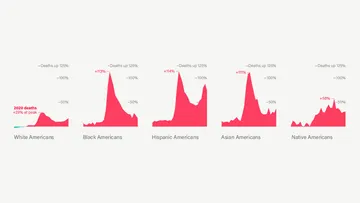This is The Marshall Project’s Closing Argument newsletter, a weekly deep dive into a key criminal justice issue. Want this delivered to your inbox? Subscribe to future newsletters.
After Vice President Kamala Harris’ quick ascent to the top of the 2024 Democratic ticket, a torrent of news, analysis and commentary on her prosecutorial career has followed. Last weekend, my colleague Lakeidra Chavis and I shared some of the key elements of Harris’ record on criminal justice issues. This week, I’m diving a bit deeper on some cases and programs that defined her time as San Francisco District Attorney and California Attorney General. Many of these items have already re-entered national political discourse, or are likely to in the coming weeks.
Writing for Politico this week, Ankush Khardori, a former federal prosecutor, argued that no prosecutor's career can be judged effectively based on simplified accounts from a few high-profile cases. “The actual work of prosecutors is much trickier than political commentators — and even prosecutors themselves — often portray it in the political arena,” Khardori wrote.
Complexity is difficult to communicate in political messaging, or even during debates. For readers likely to encounter mentions of programs and cases that Harris has been involved in, we hope this week's edition will be a handy primer to the more nuanced aspects of her record.
Death Penalty
One of the earliest tests of Harris’ career as district attorney came after a San Francisco man shot and killed police Officer Isaac Espinoza in 2004. Harris had campaigned against capital punishment and rejected calls by police groups, the officer’s family and prominent state Democratic officials to seek a death sentence. The decision permanently fractured Harris’ relationship with the city police, according to people close to Harris and police officials. The Trump campaign is already citing this case to criticize Harris.
That uneasiness between Harris and police groups persisted through her first bid for California Attorney General in 2010. But she worked to repair those relationships in her first term, according to a 2016 New York Times Magazine feature, and won the support of numerous police groups during her reelection campaign.
As state attorney general, Harris appealed a federal court ruling that would have effectively ended the death penalty in the state, frustrating anti-death penalty advocates. Harris argued that despite her personally-held convictions about the punishment, the ruling was legally flawed — a position with which the 9th U.S. Circuit Court of Appeals ultimately agreed.
Incarcerated Transgender People
On a number of issues that came up during her tenure as attorney general, Harris has said that as a lawyer, she was bound to advocate on behalf of her client (the state of California) in ways that might not align with her personal beliefs. This was her explanation for arguing to release fewer prisoners than courts had ordered after the U.S. Supreme Court found that overcrowding in California prisons was creating cruel and unusual punishment.
Harris told the LGBTQ+ outlet The Advocate that her role advocating for the state is the same reason her office composed a brief seeking to deny gender affirmation surgery for transgender people in prison. “I had clients, and one of them was the California Department of Corrections. It was their policy. When I learned about what they were doing, behind the scenes, I got them to change the policy," Harris said.
While Harris’ role is not publicly known, the department agreed to a settlement in 2015 that requires it to consider gender affirmation surgery for incarcerated people on a case-by-case basis.
Diversion Programs
One of Harris’ trademark efforts as San Francisco District Attorney was the Back on Track diversion program, which was fairly unusual for the mid-2000s, according to a then-Harris staffer, Michael Troncoso.
The program was made available to some people between the ages of 18 and 30 pleading guilty to first-time non-violent drug charges. Participants received individualized support and job training, performed community service and were required to find work or be enrolled in school. Successful graduates had their guilty pleas tossed out and scrubbed from their records.
The program, which internal documents showed graduated between 30 and 100 people every year, boasted a re-offense rate of about 10%, compared to 50% for similar populations in the state.
Harris, who majored in economics as an undergraduate, conceived the program as a series of incentives and disincentives — carrots and sticks. “Our job encompasses working unceasingly to make and keep our communities safe using every tool at our disposal,” she explained in her 2009 book “Smart on Crime.” That approach pushed back on the prevailing logic of the era: That prosecutors' only role was to win convictions.
She has spoken about the program in very practical terms. “This is not social work we are doing. This is a law enforcement program,” Harris wrote. “We did not develop Back on Track out of pity or compassion.”
Innocence Cases
In 2008, Jamal Trulove was arrested in San Francisco and prosecuted by Harris’ office for the murder of his friend Seu Kuka. An appellate court later found that police officers had framed Trulove, and he was released after six years in prison. The city agreed to pay him a $13 million settlement.
A former district attorney staffer told Vice that “prosecutions like Trulove's would have had to be approved by Harris. But the approval process was a rubber stamp, and it was highly unlikely she was familiar with the details.” Harris has not publicly commented on Trulove’s case.
As attorney general in 2010, Harris’ office also opposed DNA testing requested by the lawyers for Kevin Cooper, who had been on the state’s death row since 1985 for a quadruple murder he said he did not commit. In 2018, after a New York Times article highlighted misconduct by police investigators in Cooper’s case, Harris advocated for the state to allow the testing.
A comprehensive investigation commissioned by the state did ultimately conduct DNA testing, concluding last year that the evidence of Cooper’s guilt was “extensive and conclusive.”
Big Banks
In 2011, as California Attorney General, Harris walked away from a $4 billion settlement with several of the nation’s largest mortgage lenders over the fraudulent and unscrupulous behavior that led to the 2009 financial crisis — specifically their foreclosure practices.
The settlement was being negotiated by attorneys general from multiple states at the urging of the Obama administration, and many were advocating that states settle cases quickly for a lower amount, according to reporting from the Los Angeles Times.
Harris dismissed the deal as “crumbs on the table,” and ultimately won a $25 billion settlement for California. Harris has frequently cited the settlement as proof of her bona fides in seeking accountability from powerful actors.
Critics of the settlement say even the topline number “wildly overstates the penalty for the banks and the benefit for homeowners,” and that Harris let other banks responsible for “widespread misconduct” off the hook.
Journalist David Dayen, who reported on both of the criticisms, made clear that the analysis of the decisions was not specific to Harris, however, and applied to all the officials in charge of holding banks accountable for the mortgage crisis.
Harris has responded to the critique of the bank she didn’t go after — OneWest Bank — arguing that the law was on the bank’s side.
Truancy
Harris’ embrace of anti-truancy laws was one of the most controversial policies of her prosecutorial career. As district attorney, she directed her office to file charges against a handful of San Francisco parents whose children were consistently missing elementary school.
In her book “Smart on Crime,” Harris explains the rationale: “We owe every child an education and we owe ourselves the additional inoculation against violence and crime that fighting truancy can bring.”
Under the local effort, no parents ever faced jail time, and the fines levied were rare and small.
A Harris campaign aide touted the program’s effectiveness in remarks to NBC News earlier this week. “Truancy dropped by 33% because of the policy, and it also helped people in the community — this wasn’t one or two days; this was kids missing 60 to 80 days out of a 180-day school year.”
But as Attorney General, Harris pushed for and saw the passage of a statewide anti-truancy bill that exported some of the thinking to California as a whole. Under that law, some parents were arrested by local law enforcement and faced harsher penalties, including Cheree Peoples, who was very publicly “perp-walked” during a 2013 arrest in Orange County in Southern California. Peoples said her daughter’s school absences were due to hospitalizations for a chronic illness.
Harris has defended her focus on truancy broadly but expressed regret for how some cases were handled after the passage of the statewide law.
Learn about how The Marshall Project is covering the 2024 election’s criminal justice and immigration issues across the U.S. and in our local news teams’ cities.

